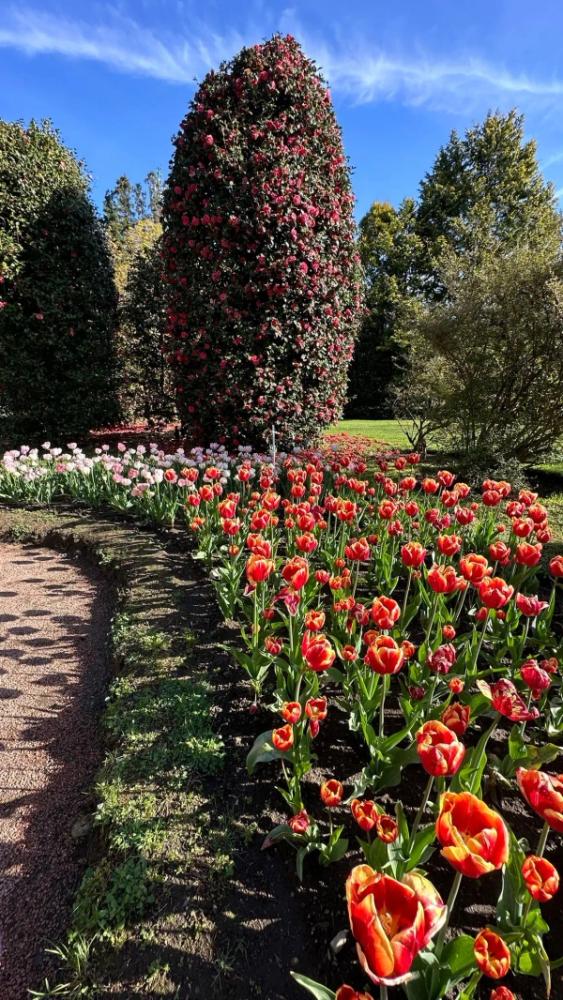History of Villa Taranto
The history of Villa Taranto (VCO) begins thanks to Scottish Captain Neil McEacharn, who purchased the property of the Marquise Sant'Elia in 1931. His intent was to create an English garden that could recall his homeland of Scotland. The fundamental aspects to be respected were aesthetic and botanical. Work was completed in 1940, after several operational phases. The botanical requirement was the most significant as the different vegetations needed to identify suitable soil and climate conditions. The Garden was named Villa Taranto in honor of an ancestor: Marshal McDonald, appointed Duke of Taranto by Napoleon. The captain's desire was to give his noble work to the future and therefore he decided to donate the property to the Italian State. Currently, the botanical holdings of Villa Taranto are extremely diverse, with 20,000 plants of particular botanical value. The Gardens were opened to the public in 1952 and from there to today they welcome visitors from April to October. Captain Neil Mc Eacharn died April 18, 1964, and his remains rest in a chapel-mausoleum built right in the park. Now it is The Villa Taranto Botanical Gardens Authority that takes care of this enchanting place.
The Botanical Gardens of Villa Taranto
The Villa Taranto Botanical Gardens (VCO) represent one of the main floral attractions on Lake Maggiore, Italy. It is a 16-hectare park where inside there are 20,000 plants of particular botanical value and 80,000 bulbous plants in bloom, in addition there are 15,000 border seedlings filling the different flower beds. The Villa Taranto Gardens undergo different color transformations according to the seasons, and it is this wonderful aspect that strikes visitors. The entrance to the park is in front of the lake, and the entire route is developed in 12 highlights starting from the tulip maze and leading up to the view of the Villa (prefectural seat of the V.C.O), the Captain's chapel-mausoleum, the Valletta, the terraced gardens and the putti fountain.
Of considerable importance, is the calendar of blooms that has been drawn up in great detail. A few examples are noted:
- 80,000 Dutch Tulips and thousands of Violets, Primroses, Poppies and Lily of the Valley bloom in April.
- In May hundreds of Azaleas are admired, and in June thousands of Petunias.
- Between July and August the real stars are the Nelumbium Ponds (Lotus Flowers).
-Between September and October, Water Lilies, Tea Plant and Winter Camellias bloom.
In addition, the Villa Taranto Gardens hold a veritable collection of rare botanical species such as Victoria Cruziana, Metasequoia Glyptostroboides and Davidia Involucrata.
There is also an area in the Gardens called the Wellness Garden: a vast green area where remarkably large benches are located where one can rest while admiring an enchanting view of the mountains. Near the entrance there is also a café-restaurant for quiet stops once the visit is over. The Villa Taranto Botanical Gardens are nothing less than an extraordinary green lung where you can live a dream.
Highlights of the Villa Taranto Garden
The Villa Taranto Garden has some extremely important points such as the Entrance Avenue known as the ''Avenue of Conifers'' due to the presence of rare specimens of conifers from all over the world. The Fountain of the Putti is another important attraction point, where the Horned Violets bloom in spring. The Dahlie Labyrinth captivates visitors with its more than 1,700 flowering plants. Also fascinating are the Serra Victoria and the Vertical Garden where the Victoria Cruziana, originally from Paraguay, is grown: it is a huge equatorial water lily whose seeds arrived at Villa Taranto in 1956. The Chapel-Mausoleum is the most prominent building within the Gardens as it houses the remains of Captain Neil McEacharn, creator of the park. The structure was designed by Renato Bonazzi and built in 1965. The polychrome stained glass windows, depicting flowers and the figure of St. Anthony of Padua, to whom the chapel is dedicated, stand out. The Valletta is another area of note: artificially excavated in 1935, it is a characteristic spot thanks to the small bridge over it. The actual Villa Taranto is a building erected by a Ticino architect, Augusto Guidini, in 1853 and is reminiscent of Normandy architecture. It is located in front of an English-style lawn graced by a fountain. The property was purchased in 1931 through an advertisement that appeared in The Times. From 1995 to the present, the villa has been the seat of the Prefecture of Verbano-Cusio-Ossola and cannot be visited. Finally, we recall the Terraced Gardens decorated with a bronze statue by Vincenzo Gemito, a Neapolitan artist.
Events and Exhibitions in Villa Taranto
The Villa Taranto Botanical Gardens (VCO) is home to seasonal events, exhibitions and festivals. The ''Bulb Festival'' in April is one of the first events to open the spring season. During this occasion, the main attraction is the Tulip Maze: a colorful path of about 400 meters, where one can immerse oneself in countless shades of magical hues. Also of notable importance are the Fai Weeks and the ''Tourist in Your City'' event. The latter is held every first Sunday of the month when the Villa Taranto Botanical Gardens Authority, in collaboration with local institutions, decides to open the gates to all residents in the municipality of Verbania. By doing so they will have the opportunity to visit the park free of charge. Afterwards, in the Gardens there are real floral exhibitions, such as the Dahlia Exhibition: an exceptional flowering that consists of a labyrinth of Dahlias blooming from the last decade of July until the end of October. More than 1,700 flowering plants divided into many varieties can be admired; all creating an enchanting spectacle of shapes and colors. Finally, the Fall Foliage, or fall foliage, majestically paints the garden with tones ranging from yellow to brown.
Conservation and Research at Villa Taranto
Villa Taranto Gardens (VCO) through its botanical enhancement activities is committed to preserving and preserving the immense park over time, while also fostering biodiversity. With the contribution of well-defined research programs, all plants and flowers in the park are studied, enhanced and offered to the public. The whole project of conservation and protection of the entire area derives from the excellent efforts that the Villa Taranto Botanical Gardens Board employs to develop and maintain over time effective methods and strategies, in the botanical field. As visitors explore the park, they will thus be confronted with a well-kept place where they can spend their time enjoying nature. Biodiversity and preservation of flower and plant species are the two basic parameters that guide the work of this enchanting cultural site. Study and research allow the immense botanical heritage of Villa Taranto to be donated to future generations, as desired by the Scottish Captain.
How to Reach Villa Taranto
The Villa Taranto Botanical Gardens are located in Italy, in Pallanza (VCO) on the western shore of Lake Maggiore and are easily accessible in the following ways:
- - By CAR: from the north center: A26 VOLTRI-GRAVELLONA TOCE, exit BAVENO/STRESA - 11 km along the SS33 towards VERBANIA.
- - By TRAIN: Milan-Domodossola line. Verbania station is 9 km from the Gardens.
- - By BOAT: through the public service of Navigazione Lago Maggiore, which also has a stop in front of the Gardens.
- - By PLANE: from Malpensa Airport. Alibus offers bus connection.
Conclusion: The Charm of Villa Taranto
The Botanical Gardens of Villa Taranto (VCO) represent one of the major botanical attractions on Lake Maggiore and are a true haven of peace where one can spend, quietly, one's free time in contact with many types of plants, trees and flowers. Natural beauty is the dominant element of the entire site and together with constant protection and study helps to make the area an important landmark for the entire community and also for all the many tourists, who come from all over the world. Visiting the Villa Taranto Botanical Gardens is like immersing yourself in a magnificent, timeless floral painting.
FAQs
What are the opening hours of Villa Taranto?
Daily, including holidays with continuous hours: - March: 9:00 a.m. - 5:00 p.m. (last entry) 6:00 p.m. closing gates - April - September: 9:00 a.m. - 6:00 p.m. (last entry) 7:00 p.m.00 gate closure - October 1 to 20: 9:00 a.m. - 5:00 p.m. (last entry) 6:00 p.m. gate closure - October 21 to 27: 9:00 a.m. - 4:00 p.m. (last entry) 5:00 p.m. gate closure - October 28 to November 3: 9:00 a.m. - 3:30 p.m. (last entry) 4:30 p.m. gate closure
Is it possible to participate in guided tours within the gardens?
Yes, within the gardens it is possible to participate in guided tours.
What are the rarest or most famous plant species I can expect to see at Villa Taranto?
At Villa Taranto you can see both rare plants such as Victoria Cruziana and famous plants such as Tulips.
Are there any special events or flower shows scheduled throughout the year at Villa Taranto?
Yes, there are special events and flower shows scheduled throughout the year at Villa Taranto such as ''The Bulb Festival'' in April.




